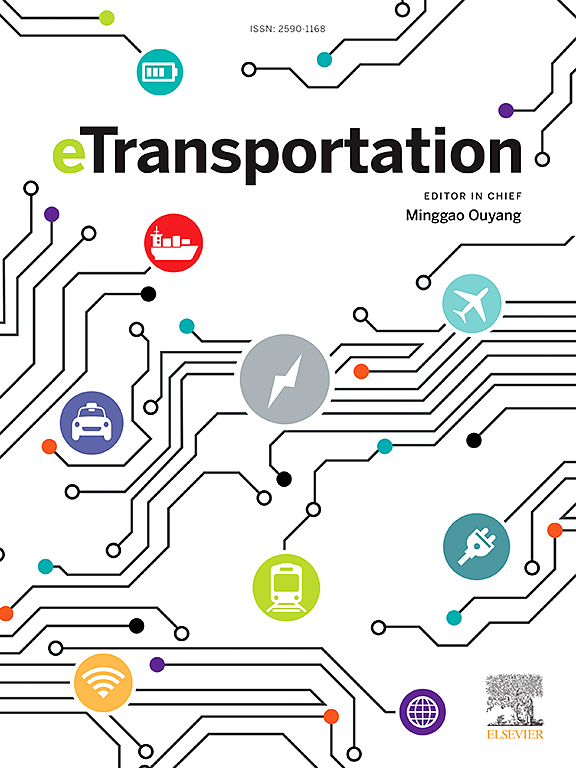Quantifying the flexibility potential of electric vehicles in buildings and determining the investment strategy for charging infrastructure
IF 17
1区 工程技术
Q1 ENERGY & FUELS
引用次数: 0
Abstract
Buildings and electric vehicles (EV) play complementary roles in the energy system, enhancing flexible electricity demand through the integration of charging stations within buildings. This study addresses the gap in quantifying the flexibility potential of EVs within buildings and developing investment strategies for charging piles, which have been overlooked in previous research. To tackle this, we propose an equivalent energy storage model and introduce the discount factor as a metric to assess EV dispatch capabilities and optimize the charging infrastructure installation. The research employs three charging modes and a mixed-integer linear programming (MILP) optimization framework to minimize net load variability. Key results demonstrate a tradeoff between the number of charging piles and dispatch capability. Bidirectional smart charging (BSC) significantly enhances flexibility, while charging piles exceeding 30 kW offer limited benefits. Furthermore, integrating photovoltaics (PV) substantially increases dispatch potential, with PV penetration above 20 % making charging pile investments more advantageous than battery. Once PV penetration exceeds 40 %, nearly all parking spaces in buildings can accommodate charging piles. The study quantifies EVs’ equivalent storage capacity and concludes that strategic investment in slow charging piles and high PV penetration is highly effective. This work introduces new metrics for evaluating EV dispatch capability and develops investment strategies for charging piles based on their comparative advantage over batteries. It also highlights the cost-effectiveness of EV infrastructure in enhancing energy flexibility, providing a clear roadmap for optimizing investments in EV charging systems.
量化电动汽车在建筑物中的灵活性潜力,确定充电基础设施的投资策略
建筑物和电动汽车在能源系统中发挥着互补的作用,通过建筑物内充电站的整合,提高了灵活的电力需求。该研究解决了在量化电动汽车在建筑物内的灵活性潜力和制定充电桩投资策略方面的空白,这在以前的研究中被忽视了。为了解决这个问题,我们提出了一个等效的储能模型,并引入折扣系数作为评估电动汽车调度能力和优化充电基础设施安装的指标。该研究采用三种充电模式和混合整数线性规划(MILP)优化框架来最小化净负荷变化。关键结果表明了充电桩数量和调度能力之间的权衡。双向智能充电(BSC)显著提高了灵活性,而超过30千瓦的充电桩带来的好处有限。此外,整合光伏(PV)大大增加了调度潜力,光伏渗透率超过20%,使得充电桩投资比电池投资更有利。一旦光伏渗透率超过40%,几乎所有建筑物的停车位都可以容纳充电桩。该研究量化了电动汽车的等效存储容量,并得出结论,对慢速充电桩和高光伏渗透率的战略投资是非常有效的。本文引入了评估电动汽车调度能力的新指标,并根据充电桩相对于电池的比较优势制定了充电桩的投资策略。它还强调了电动汽车基础设施在提高能源灵活性方面的成本效益,为优化电动汽车充电系统的投资提供了明确的路线图。
本文章由计算机程序翻译,如有差异,请以英文原文为准。
求助全文
约1分钟内获得全文
求助全文
来源期刊

Etransportation
Engineering-Automotive Engineering
CiteScore
19.80
自引率
12.60%
发文量
57
审稿时长
39 days
期刊介绍:
eTransportation is a scholarly journal that aims to advance knowledge in the field of electric transportation. It focuses on all modes of transportation that utilize electricity as their primary source of energy, including electric vehicles, trains, ships, and aircraft. The journal covers all stages of research, development, and testing of new technologies, systems, and devices related to electrical transportation.
The journal welcomes the use of simulation and analysis tools at the system, transport, or device level. Its primary emphasis is on the study of the electrical and electronic aspects of transportation systems. However, it also considers research on mechanical parts or subsystems of vehicles if there is a clear interaction with electrical or electronic equipment.
Please note that this journal excludes other aspects such as sociological, political, regulatory, or environmental factors from its scope.
 求助内容:
求助内容: 应助结果提醒方式:
应助结果提醒方式:


